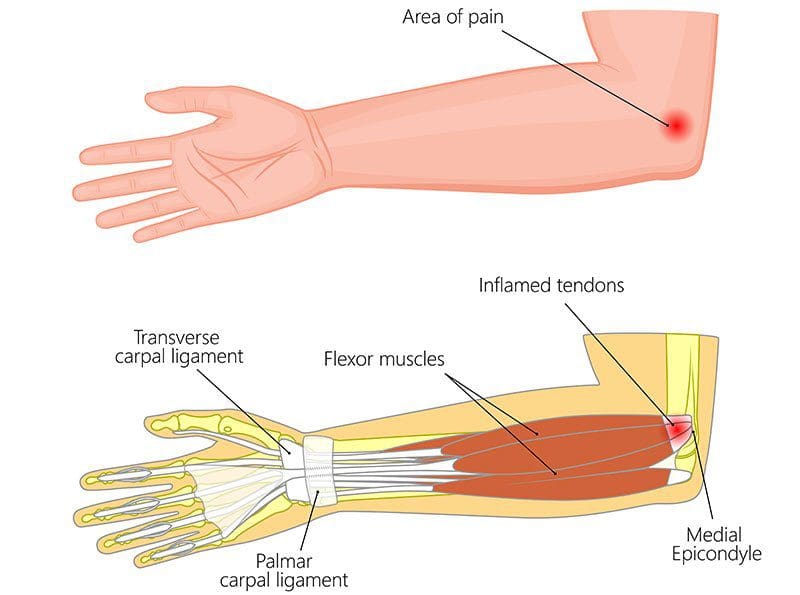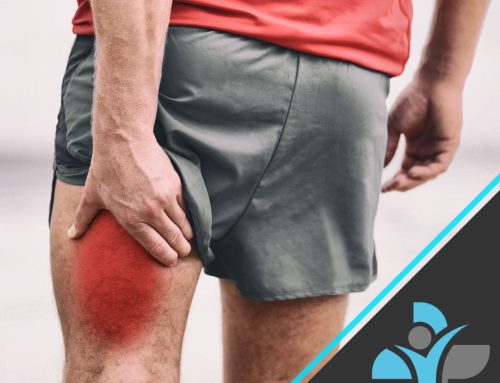Overview
Golfers elbow, clinically known as medial epicondylitis, is a condition that causes pain around the inside of the elbow joint. Often occurring after repetitive overuse of the forearm muscles and tendons used for moving the wrist and hand. Due to the constant strain of the wrist flexors on the insertion (attachment) point, inflammation or micro tears can occur.
Golfers elbow is a musculoskeletal condition usually seen in people aged 40 – 60, whose daily activities include repetitive wrist flexion. Despite generally being diagnosed in golfer’s, the injury can occur in several other professions or sporting activities.
The level of pain associated with the pathology can vary from a mild niggle to a severe ache. Fortunately there are many different treatments available to help, with more than 80% of people recovering with basic treatment.
Anatomy
Your elbow joint is a joint consisting of 3 bones. The first is in your upper arm and known as the Humerus. The other 2 bones are in your forearm and known as the Radius and Ulna bones. At the bottom of the humerus there are small bony prominences called epicondyles, where muscles within the forearm attach. The bony prominence located on the inside side of the elbow is called the medial epicondyle.
Muscles, ligaments, and tendons play a huge role in holding the elbow joint in position with strength but also flexibility to move.
Medial epicondylitis, or Golfer’s elbow, is a condition that affects the muscles and tendons of your forearm which attach onto the medial epicondyle. Research suggests that the flexor carpi radialis (FCR) and the pronator teres are the muscles most commonly affected.

Symptoms
The symptoms of golfer’s elbow usually develop over a long period of time. In the vast majority of cases the pain can be minor and more of a side note but can worsen over time. In most cases there is no specific mechanism of injury associated with the condition, it is usually due to repetitive overuse.
Common signs and symptoms of tennis elbow include:
- Pain or burning on the inner part of your elbow
- Weakness or pain when gripping, lifting or twisting objects
- Pain when straightening the arm
- Sometimes, pain at night
The symptoms are often worse when the forearm is being used in activities that can be as simple as pouring water into a cup, using a screw driver even shaking hands.
Causes
Overuse – As mentioned previously the underlying cause of Golfer’s elbow is overuse, causing the tendons of the muscles to become inflamed. Overtime this inflammation can lead to small tears within the tendon or muscle. Recent studies have shown that particular muscles when damaged can play a large part in the cause of Golfer’s Elbow. These muscles are located in the forearm, known as the flexor carpi radialis (FCR) and the pronator teres. When these muscles become injured or weak from overuse they can get very tight causing the muscles to shorten and pull on the tendons at the insertion point. This constant pull on the tendons is what then causes the inflammation and micro tears, resulting in pain.
Activities – Activities play a large part in the cause of Golfer’s Elbow (Medial epicondylitis). As you would expect Golf and other sports are a factor in the case of Golfer’s Elbow (hence the name) however, anyone can get it and it could even be down to work related overuse. Professionals such as Plumbers, Electricians, Carpenters, Factory Workers and Office Workers can get this condition, any work where grip and wrist strength is important.
Age – Anyone can get Golfer’s Elbow at any stage in their life depending on the activities they are doing and how they are using their arm. That said, the majority of cases we see can range between the ages of 40 and 60.
Diagnosis
When discussing this issue with your doctor, they will take into consideration a number if factors before making a diagnosis. These will include how your symptoms developed, your work and your hobbies etc.
The Doctor will discuss how and when the symptoms occur and are more severe and where on the arm the pain / symptoms are materialising. You will need to make sure you inform your doctor of any underlying health issues such as Arthritis (RA or Osteo), you you have injured your elbow in the past or any other medical issues that has a baring on your elbow.
There are a number of tests the doctors can and should perform during your examination such as asking you to try straighten your wrist and fingers with the doctor providing resistance with your arm straight.
Your doctor may recommend additional tests such as X-rays, Magnetic resonance imaging (MRI) scan or an Electromyography (EMG) – this will be to rule out nerve compression.
Treatment
Golfer’s elbow is a condition that will eventually get better over time, the length of time will be determined by how much you are using the arm in the way in which it was damaged in the first place. This may mean you will need to stay off certain activities indefinitely for a period of around 6-8 weeks. This could be shorter or longer depending on what state the injury is in.
However, there are treatments that can be used to speed up your recovery and ultimately help alleviate symptoms while you recover.
The first stage in any recover is
REST. It is important you rest your injured arm and stop doing the activity that’s caused the problem in the first instance.
ICE – Apply a cold compress to the injured arm, such as a bag of frozen peas or a sports ice pack / gel pack for a few minutes several times a day, this will reduce inflammation and ease the pain. Some people have great success with contrast bathing the area so for example, icing the joint itself (the bony / tendonous areas) and using heat on the muscular areas such as Forearm to relax the muscles and speed up recover.
PAINKILLERS – Taking Paracetamol to ease the pain and Non-Steroidal Anti-Inflammatory’s such as Ibuprofen to reduce the inflammation can help greatly whilst in recovery.
MASSAGE – Asking your personal Sports Therapist / Massage Therapist to perform massage on the arm offering STR (Soft Tissue Release) as well as general massage to relax the area and stimulate blood flow can really help to speed up recovery and make you feel better.
PHYSIOTHERAPY – Physiotherapy should be considered with other conservative treatment options especially for more severe and persistent cases.
A good rehabilitation plan with those elements mentioned above has seen great results and improved recovery time as well as reduced inflammation, reduced pain and improvement to the range of movement in your arm.
SURGERY – may be an option if the issue persists and you have gone through a considered and tailored physiotherapy and massage program as a last resort to remove the damaged part of the tendon.
Exercises
There are a number of exercises you can perform to help in the Recovery of Golfers Elbow but also to help strengthen the area to help in the prevention moving forward. We have put together a video of some of the popular and most effective exercises / rehabilitation programs for this condition.
Prevention
It’s not easy to avoid getting golfers elbow as it can be very minor issues that cause it. However a dynamic and considered training program with a qualified strength and conditioning coach can really help. Further to this if your injury was caused through overuse then looking at reducing that particular activity until you have strengthen the area or looking at other ways to do the task in question will help.
The video above is not just to help rehabilitate the area it will also help in strengthening the area and again you should seek professional advice for this.



